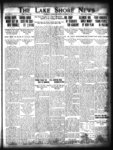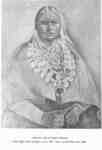The First Chapter of a Short Historical Sketch of the Village of Wilmette
- Publication
- Lake Shore News (Wilmette, Illinois), 10 Sep 1914, p. 1
- Full Text
The early history of Wilmette is so closely intertwined with that of Chicago, and in fact with that of the entire region between Chicago and Waukegan, which has, in recent years, become known as the north shore, that it is a difficult task to give the one without referring more or less frequently to that of the other. It is a history around which much of romance has been wove,, dealing as it does with heroic deeds performed and untold hardships endured by the sturdy pioneers, unto whom must be given the credit of converting this region from a wilderness into one of the most beautiful residential districts to be found anywhere within the length and breadth of this country.
The written history of Illinois began with the arrival of Marquette and Joliet at the mouth of the Chicago river in 1673. At that time this part of the state was in the possession of the Illinois and Pottawatomie tribes of Indians. The southern part of the state, made accessible by the Ohio and Mississippi rivers, was settled long before the northern part, and at the time Illinois was admitted into the Union (1818), its population of fifty thousand was found chiefly in the southern portion.
This, then, was the condition of northern Illinois in 1790, when Antoine Ouilmette, a hardy young Frenchman, born on Canadian soil, and the man after whom this village was named, coasted down the western shore of Lake Michigan in his "bateau" and landed at the mouth of the Chicago river.
Ouilmette was in the employ of the American Fur company, and is said to have been a progressive, energetic man of good business ability, which statement is substantiated by the fact that he, in the ourse of a very short time, not only owned a small store in Chicago, but was also the owner of a great many horses, oxen and sheep. In 1796 he married Archange, a Pottawatomie woman, whose tribe was at that time living at "Grosse Point," which name served to indicate the locality situated along the shore generally within the space later known as "Ridgeville Township." This is the first north shore wedding of which there is any history. Ouilmette's wife was a half breed, her father having been a French voyageur by the name of Francois Chevallier. (The authority for this statement is I. J. Martell, a grandson of Ouilmette, who now lives in Kansas City, Missouri.) Ouilmette had eight children (besides an adopted daughter), one of whom, Sophia, was living as late as 1905 on the Pottawatomie Indian reservation at St. Mary's, Kansas.
In addition to looking after his store in Chicago, Ouilmette carried on an extensive trade along the western shore of Lake Michigan as far north at Milwaukee, and even up into Canada, and he it was upon whom the garrison of Fort Dearborn, before the massacre of 1812, largely depended for their supply of fresh meat and fuel. Ouilmette, by virtue of having married one of their own blood, possessed a powerful influence over the Pottawatomies, and at the time of the Fort Dearborn massacre (1812), he was instrumental in saving the lives of at least two white settlers. A general exodus of white settlers and their families from this part of the country followed immediately after the massacre, and for four years, or until 1816, Ouilmette was the only white resident of Chicago.
About 1826 or 1827, Ouilmette and his family moved from Chicago to the north shore and built a log cabin on the lake shore a little north of what is now called Lake Avenue, or due east of the present site of the Ouilmette Country Club house. Within the memory of old residnets the former site of this house has been washed away by the lake, together with many acres of land. This house was later used as a tavern by one Joel Stebbins, and was finally torn down in 1865 by John G. Westerfield, who had acquired that part of the reservation. [see Frank R. Grover's "Antoine Ouilmette."] .
In the year 1829, by the treaty of Prairie du Chien, which was made between the United States government and the Pottawatomie, Chippewa and Ottawa Indians, There was deeded to the wife of Ouilmette a large tract of land that from that time became known as the "Ouilmette Reservation."- Featured Link
- Media Type
- Newspaper
- Item Types
- Articles
- Clippings
- Notes
- French Canadian fur trader, Antoine Ouilmette, built the first home here in 1826.
- Date of Publication
- 10 Sep 1914
- Subject(s)
- Corporate Name(s)
- Wilmette (Ill.)
- Local identifier
- Wilmette.News.296668
- Language of Item
- English
- Copyright Statement
- Copyright status unknown. Responsibility for determining the copyright status and any use rests exclusively with the user.
- Contact
- Wilmette Public LibraryEmail:refdesk@wilmettelibrary.info
Website:
Agency street/mail address:1242 Wilmette Avenue
Wilmette, IL
60091-2558
U.S.A. Phone: 847-256-6930




